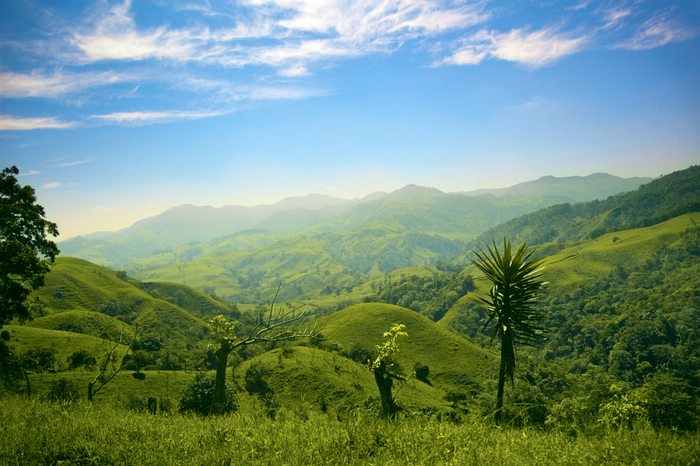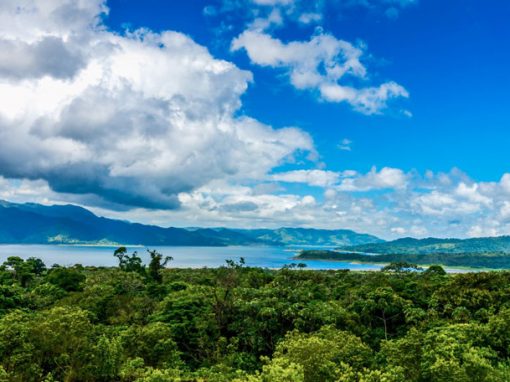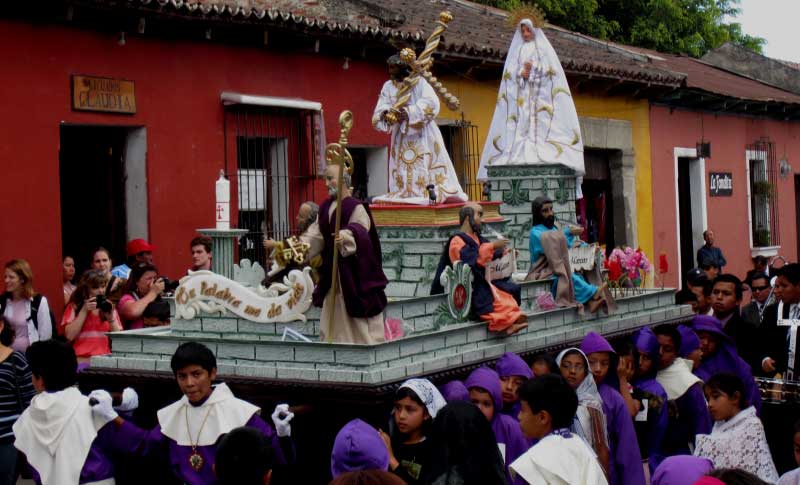The clue is in the name: la Costa Rica, the Rich Coast, has long been known for its astonishing wealth of natural life, an abundance of biodiversity that places it at the top of every nature lover’s vacation wish list. And thankfully, given the country’s diminutive size, this natural richness is easily accessible to visitors while enjoying their Costa Rica vacations. But with almost 30% of the country designated as environmentally protected land, the only dilemma is in trying to figure out which of the 35 national parks you should squeeze in to one Costa Rica vacation. Choosing between Costa Rica’s numerous national parks is no easy task but the following profiles, based on first-hand Costa Rica travel experience, should help.
1. Monteverde Cloud Forest Reserve
This dense blanket of mountain-side cloud forest is over 10,000 hectares in size and is among the most popular of Costa Rica’s protected areas thanks to its ethereal, mysterious atmosphere, stunning mountaintop views, and a vast collection of exotic, but often elusive, wildlife.
The Monteverde Cloud Forest Reserve is owned and maintained by a private, non-profit organization, the Tropical Research Center. There are over 10km of trails through the reserve with marked routes of varying lengths. The trails are well maintained and access is easy for all visitors, but paths can get muddy year round so bring sturdy boots.
A popular bird-watching destination, the reserve is home to hundreds of bird species. Monteverde cloud forest is particularly well known for its most glamorous inhabitant, the resplendent quetzal, although sightings of this shy bird are fairly uncommon. Other mammalian locals include sloths, howler monkeys and the guinea-pig like agouti.
The nearby town of Santa Elena is a quaint settlement with enough hotels and restaurants to cater for the area’s popularity, but as with all Costa Rica hotels, consider booking ahead to ensure availability.
Hiring a guide is highly recommended, to help spot some of the wildlife hiding above your head in the trees.
Entrance fee: $16. Information office opening hours: 7am-4pm.
Insider’s Tip: Monteverde cloud forest is a justifiably popular stop on a Costa Rica vacation, the only drawback being the number of visitors the reserve attracts on a daily basis. For a much quieter experience with a higher chance of spotting some of the area’s timid wildlife, try the neighboring Santa Elena reserve too.
2. Corcovado National Park
For visitors looking for a much more secluded spot during their Costa Rica travels, the Corcovado National Park, at the country’s far-southern tip on the remote Osa Peninsula, is the idea destination.
This is the most isolated of Costa Rica’s national parks; arriving here usually requires an internal flight followed by a boat transfer. But your perseverance will be handsomely rewarded: Corcovado is home to over 40,000 hectares of protected land which include no less than thirteen separate ecosystems.
This national park is a true natural gem, the only major lowland tropical forest left in the world, it is home to a bewildering number of species including jaguars, pumas, tapirs, crocodiles, giant anteaters, sloths and numerous species of monkey.
In total, Corcovado is a refuge for around 500 species of tree, 400 types of bird, 140 separate species of mammal, and over 100 types of reptiles and amphibians. Furthermore, thanks to the region’s under visited tranquility, the chance of actually seeing some of these creatures is much higher than elsewhere.
Getting to the peninsula, arranging accommodation in the national park and finding a reliable and professional guide can be a tricky business, so it is recommended to book one of the Corcovado tours from reputable Costa Rica tours operators.
Insider’s Tip: Having made the journey to this distant corner of Costa Rica, it makes sense to stay for at least four days and see as much of the Osa Peninsula as you can. Another nearby gem is the Caño Island Biological Reserve, a short boat journey across Drake’s Bay. This beautiful island is popular for snorkeling and scuba trips and can be visited as a day excursion from the mainland.
3. Tortuguero National Park
From one extreme to another, Tortuguero National Park is almost as isolated as Corcovado, but lies several hundred kilometers away on the far northern side of Costa Rica’s Caribbean coast.
This 32,000 hectare park is home to some unusual geography, not quite ocean and not quite dry land, the semi-marine environment is made up of interconnected lagoons, rivers and manmade canals, plus thick mangrove swamps, marshes and sandy beaches, all of which provide an ideal home to a huge concentration of exotic wildlife.
Perhaps the area’s most famous inhabitants are the female green sea turtles who return to the sands on which they were born to lay their eggs before heading back out to the ocean. This event is a major attraction and it is possible to visit the beaches and witness the culmination of the turtles’ epic annual voyage.
Aside from turtle watching, Tortuguero’s waterways are ideal for guided boat trips to spot some of the region’s other wildlife, including spider monkeys, capuchins, sloths and manatees, plus huge numbers of bird species.
Most visitors choose to stay within the national park itself in a jungle-style lodge, although it is possible to stay in a hotel in the nearby Tortuguero village, from where you can take excursions into the park.
As with Corcovado, Tortuguero National Park is remote and fairly inaccessible. Although it is possible to get here on your own, Tortuguero tour packages are a convenient way to visit the area and will also guarantee the quality of your lodge and guide.
Insider’s Tip: If you want to make your own way to Tortuguero, give yourself plenty of time to get there and back as the journey involves a road journey from San Jose to Caño Blanco via Siquirres, followed by a boat ride to Tortuguero village, which can take up the best part of a day.
Cahuita National Park
Heading further south down Costa Rica’s Caribbean coast eventually brings you to a much more accessible stretch of the country, a place where the Caribbean influence remains strong, especially in the vibrant town of Puerto Viejo.
The nearby village of Cahuita, although much sleepier than its vivacious neighbor, is home to a small but attractive reserve, Cahuita National Park.
The long, narrow park runs along the coast south of Cahuita and is characterized by its thick, tropical vegetation, with coconut palms swinging directly out over the white sands and blue waters of the Caribbean coast.
Scores of crabs scuttle across the narrow stretch of sand and further inland the trees are home to sloths and howler monkeys alongside ibises and herons. Particular favorites are the bold capuchins who happily approach their visitors, pose for photos and try to make off with the occasional snack from unguarded picnics. Remember, feeding the animals is strictly forbidden as it can upset the delicate balance of this fragile ecosystem.
Insider’s Tip: This is one of the most accessible national parks in Costa Rica and makes for a pleasant day’s hike from the town of Cahuita. The secluded beaches are inviting and the waters are warm, but beware of the dangerous riptides and only swim in marked areas. Snorkeling the reef is a popular activity but access is only allowed with an official guide.
Manuel Antonio National Park
Finally, another of Costa Rica’s smaller and more accessible protected areas, Manuel Antonio National Park is handily situated a few hours from San Jose on Costa Rica’s Pacific Coast near the town of Quepos.
A beautiful arrangement of tropical forests, secluded beaches and ocean views make this one of the most attractive parks in Costa Rica, although its beauty is also its curse, as the park draws a steady stream of visitors year round, making it one of the busiest national parks in the country.
But all these visitors are here for a reason: Manuel Antonio is a refuge for a huge volume of wildlife and provides a scenic environment for hiking, swimming and exploring along the well maintained trails.
A visit to Manuel Antonio guarantees sightings of the park’s monkey population, and if you’re lucky you’ll also catch a glimpse of the sloths, armadillos, iguanas and snakes, among many others, all of which make their home here.
Manuel Antonio tours operate from the town of Quepos and can be booked in advance or you can hire a private guide at the park.
Insider’s Tip: Manuel Antonio National Park is perhaps the most visited of all Costa Rica’s national parks so those looking for some serious wildlife watching should probably head elsewhere, or aim to visit away from the peak season from January to March.

Latin America for Less is a group of travel experts who live, work, eat, and breathe all things South America. Their inspiration stems from a deep appreciation for the beauty and diversity that make this continent so special.





Mitch Bennett
October 1, 2009 at 10:36 pm
Great post. I happened upon your blog through a comment on “The Amazon Raft race”. I was scrolling down your blog & had a flashback as I saw the photo of the beach at Manuel Antonio National Park (huge sigh). This is one of my favorite places on earth. It is absolutely amazing. I need to go back & cleanse myself of rat race stress. Pura Vida.